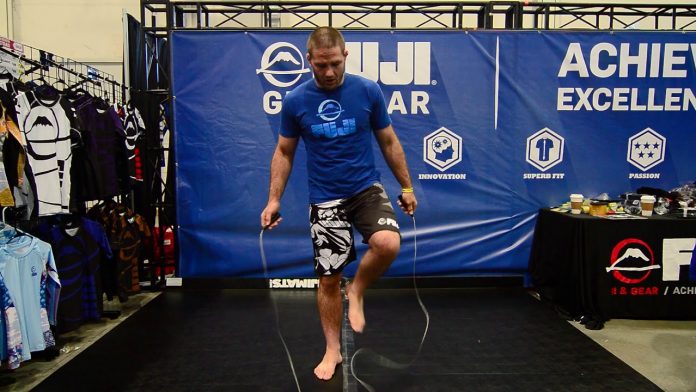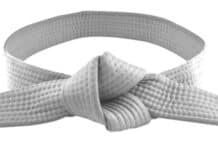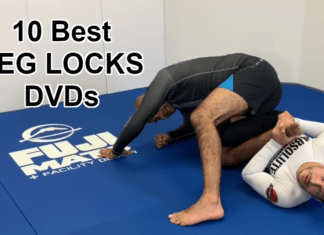
When it comes to conditioning for Brazilian Jiu-Jitsu and grappling martial arts, in general, a lot of specific work is required. Being in shape to grapple is no easy feat. It requires either lots of experience or lots of athleticism. Having both is going to make you really hard to deal with, which is what most grapplers are after. However, while specific strength and energy system work is a huge part of grappling conditioning, some of the older methods should not be abandoned. Long slow distance running has its benefits, as proven over and over again by boxers, wrestlers and the like. And so does rope jumping.
In today’s world of Bosu ball 1-arm handstands, while juggling sledgehammers with your feet, a step back to basics can only help. While lots of modern methods work, some are just pure speculation and result in more harm than good. Rope jumping is one of those methods that can only help grapplers. One of the reasons why it is often overlooked is the fact hat it is monotonous, similar to jogging. In order ot break up the boredom, we bring you the top rope jumping variations a grappler can do to get in amazing shape!
Why Should Grapplers Jump Rope
Jump rope training can benefit everyone. You can use it for long periods at a low intensity, for high-intensity bursts, or anything in-between. It’s also one of the most portable pieces of gym equipment in existence. It can be done just about anywhere.
The problem with traditional rope jumping, as we said, is boredom. Due to the repetitive motions of the exercise, many people tend to lose patience and abandon it. And grapplers are not known as the most patient athletes in combat sports. There’s not much excitement in using both feet to repeatedly hop in place. But have you ever watched a skilled boxer train? Their dance with the rope looks anything but boring. Or easy to perform for that matter. Getting to the point where you can swing the rope and move your feet like a boxer will yield great health and performance benefits.
In terms of Jiu-Jitsu conditioning, it is going to improve your cardio and raise your endurance significantly. It also works on abilities like eye-hand coordination, agility, balance, and speed. Rope jumping even results in certain strength benefits, like forearm and ankle tendon strength.
Get In Fighting Shape Fast And Lose Fat Along The Way: https://bjj-world.com/jiu-jitsu-workout-program-to-lose-fat/
Now, despite being a simple conditioning tool to use, rope jumping, like any other training method, requires correct programming. Even if you learn all variations of skipping, training blindly without a clear progression system is of no use. In that sense, we’re going to offer you various jumping patterns along with appropriate progressions. Read on!
The Basic Rope Jumping Pattern
When a boxer jumps rope, one of his objectives is to mimic the footwork used during a fight. Instead of hopping on both feet with an even amount of weight distribution, they shift the weight from leg to leg with each jump. This allows for more active movement and also puts less strain on the calf muscles. Alternating feet means your calf muscles get a slight rest with every jump, which is helpful, especially for beginners.
With the boxer style of rope jumping, the feet are always slightly offset. This way one leg absorbs slightly more landing force than the other. This provides the ability to move in any direction at any time. It’s also a much more efficient footwork pattern.
Rope jumping in this manner is a great way to prevent shin splints because it produces less impact. It also allows you to conserve energy and jump rope longer. When experimenting with the basic skip, imagine lifting your feet off the ground to create a jump as opposed to pushing them off the ground.
Going Sideways
Even if you’re an absolute beginner and have never trained rope jumping, you still need to do side swings. Side swings are a great way to learn how to correctly jump rope. They teach you how to coordinate rope and foot speed without the need to actually jump As you advance, you can also use side swings as transitions between different types of swings and footwork.
Your basic side swings begin with a sideways figure-8 pattern. The rope will start to track behind you and loop around to the front on your right side. Then, it continues in the same pattern on the left side. Keep the rope going by continuing this figure-8 motion.
To progress, single-arm side swings are next on the list. The only difference is that you’ll need to hold both handles in the same hand. Practice moving the rope with both the right and left arm.
Transitioning into full skips from swings require you to bring both hands to where they normally are for a single rope turn. Separate the rope as it’s coming around, just before you’d start swinging to the opposite side. You should look to get comfortable with opening the rope up. You’ll soon get used to the timing.
Finally, go for the full side Swings while moving your feet. To do this rope jumping variation, first practice side swinging while moving your feet without trying to jump in. Only, once you’re comfortable, jump in every so often. Before going all in.
No Time? No Problem! Quick Workouts For Busy Grapplers: https://bjj-world.com/quick-jiu-jitsu-conditioning/
Cross Jumping
Being able to criss-cross the jump rope is impressive, but difficult to learn. Crosses are especially challenging to pick up. There’s no point in attempting them before mastering other skipping basics first. These progressions will teach you to cross the rope in no time, provided you already have certain experience in rope jumping.
To start with, place the rope behind you and twirl it over your head as if you were going to start jumping. As the rope passes your head and starts to come down, cross your arms. Don’t even try to skip over it at this point. Just drag the rope into your toes. Step over it and repeat the motion until you’re used to it. You need to be comfortable with the position of your arms before you think about jumping. When crossing, the goal is to completely displace your hands.
The next step is jumping over the as it comes through. Only jump once and don’t worry about what the rope does after. Reset and repeat until you’re familiar with the jump pattern. Later on, you’ll add in a jump over the uncrossed rope as well. You’ll jump over the crossed rope first, and then you’ll jump over it as it is returning. Uncross the rope at exactly the same point as you crossed it (as it’s coming down in front of you).
Stringing together crosses is the final piece of the puzzle. As long as you’re able to keep a good rhythm with the first and second jump you’re good to go. Keep the rope and your feet going at a consistent rate to maintain the rhythm.
Doubling The Skips
The double-under is a rope jumping technique in which the rope turns two times on a single jump. A double-under cross is a skip in which the rope crosses and uncrosses on a single jump. Both of these variations are more about rope speed than height.
To learn to double-under, begin turning the rope as with the basic jumping pattern. Jump slightly higher on the fifth jump as you turn the wrists twice instead of once. Try to get the rope to pass under your feet twice before landing back. Get familiar with this before you attempt to string double-unders together.
Double-under crosses look much tougher than a regular double-under, but they actually aren’t. The only condition is having the crossing rope jumping technique mastered. Instead of the wrists producing the double rope turn, your arms will control the rope to complete a double-under cross. Learn these the same way you learned the double-unders – on every fifth skip, jump slightly higher, cross, then immediately uncross the rope before landing.












































